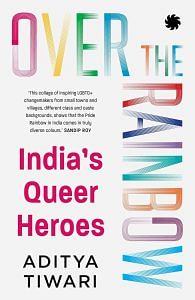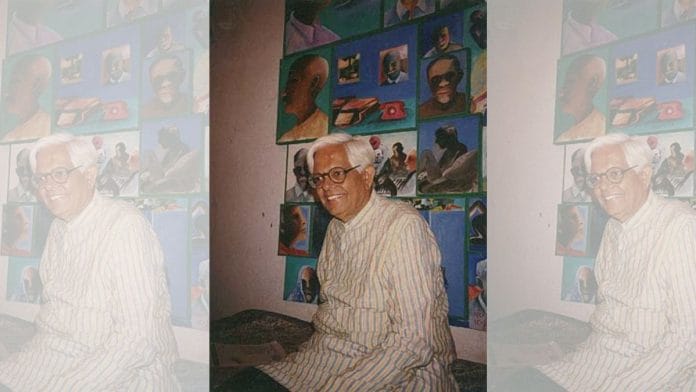Two kinds of icons stand out visibly in this book – those who have fought actively for LGBTQ+ rights and those who have been extremely successful in their fields and have been open about their sexuality, thus becoming role models for many Indians. But there is also a third category of people – those like filmmaker Rituparno Ghosh, who not only have achieved success in their professions and been open about their sexuality but have made their sexuality a central theme of their work, thus taking LGBTQ+ issues to a wider world.
Artist Bhupen Khakhar belonged to this category. A Padma Shri awardee, described as ‘possibly the most provocative painter in contemporary Indian art’, he remains the country’s most important gay artist, one who achieved great recognition for his work both in India and internationally and who made homosexuality a central plank of it.
Bhupen was born in 1934 in Khetwadi, Bombay. His family pressured him into a traditional career path and instead of following his dreams and heading to art school, the young man ended up studying economics, commerce and later qualified as a chartered accountant. This would be his formal profession for the next twenty-seven years of his life. Bhupen’s passion for art persisted, leading him to join evening art classes at the Sir J.J. School of Art in Mumbai in 1958 while he worked as an accountant by day.
Also read: Raja Ravi Varma, the royal artist who became part of daily life through calendar art
At thirty, he finally decided to plunge into art and went to Baroda University (known for its new and exciting fine arts faculty) to do his master’s in art criticism encouraged by the painter, Ghulam Mohammed Sheikh. It was Sheikh who pushed him to become a painter. Bhupen eventually moved to Baroda, settling among a vibrant community of artists, which included Sheikh, Vivan Sundaram and Sunil Patwardhan – becoming a part of what is today known as the Baroda School.
He began painting in his early thirties, during the 1960s, holding his first solo exhibition in Bombay and then showing his work across the country and internationally in shows such as Art Now in India, London, Newcastle and Ghent, IX Biennale de São Paulo and the First Triennale-India, New Delhi. It was at the Triennale in 1968 that he met the great British artist Howard Hodgkins, who was to become a lifelong friend and mentor. Hodgkins would later say of his first sighting of Bhupen’s work – ‘I felt they were the only ones there that were original. They had their own identity. They were three narrative pictures. Their authenticity shone out like a sound of a bell in this terrible, crowded exhibition.’
Bhupen’s early works reflected his experimentation with various styles and techniques. He drew inspiration from both Western art movements, such as Pop Art and Surrealism, and traditional Indian art forms, and was regarded as India’s first true pop artist. His first big series –the Tradesmen series – was made in the 1970s, as a play on the nineteenth-century Company School pictures, which portrayed ordinary Indians often at their work.
In his series, Bhupen painted working-class men (some who became his friends, others lovers) – the barber, the watch repairman and even the assistant accountant he worked with. Artforum reports, ‘In one, a sign announces “DE-LUXE TAILORS”. In another, a doormat promises “GOOD LUCK”. These paintings dip into the vernacular, even kitsch, the language of the bazaar. “Good taste can be very killing,” the artist once said.’
In 2017, Sotheby’s would sell De-Luxe Tailors (given by Bhupen to Hodgkins as a gift ), a 1972 painting from the series, for $1.4 million.
In 1979, Bhupen spent six months in Britain working as the Bath Academy of Arts’ resident artist, after which he participated in a show called ‘Narrative Painting’ in London. During his time in England, he saw the growing acceptability of homosexuality, a decade after it had been made legal, and interacted with the famous gay artist David Hockney.
He would say how important those six months had been and that it had allowed him to see how men could live with other men. In 1980, Bhupen’s mother died after which he began to fearlessly incorporate his sexuality into his work. His paintings became his coming out. ‘I did not announce it verbally, but there were paintings that related to gay Subjects,’ he said.
Bhupen’s exploration of his identity through art resonates with historical perspectives on sexualities, as seen in ancient texts that defined various forms of desire and identity.
This groundbreaking move made Bhupen the first Indian artist to declare his homosexuality openly. His paintings, such as You Can’t Please All and Two Men in Benares, presented a raw and honest portrayal of queer experiences, challenging stereotypes. The artist would say, ‘I have chosen homo-eroticism as a theme because I am gay. What is happening in India – social rejection – did happen once in countries like the USA and Europe. The police in all societies have beaten up gays and lesbians. But now they have been accepted by society. For me, there is nothing unnatural about homosexuality.’
Of this phase, Two Men in Benares (1982) is perhaps his most iconic work. The painting depicts two naked men with erect penises, embracing each other. Despite its explicitness, the atmosphere of the picture is profoundly tender and intimate. Bhupen described it and his work during this period as his attempt to create ‘an iconography of homosexual love’.
It was sold for Rs 22 crore (£2.54 million) by Sotheby’s in 2019. Despite the boldness of his work, he did feel the effect of coming out so openly. ‘Now I feel amused, but at that time I felt very pressured because in India there are hardly any painters doing gay subjects . . . I felt ostracised and even my friends advised me to see a doctor,’ he said.
The 1980s were a time of great recognition for the artist. In 1982, Hodgkins curated an important show at the Tate Museum called ‘Six Indian Artists’. They included some of the country’s most important modern artists – Abanindranath Tagore, Jamini Roy, Amrita Sher-Gil, M.F. Husain and K.G. Subramanyan. Hodgkins also included Bhupen Khakhar, who went on to play another kind of role in the art world. From 1985 to 1988, he served as the honorary secretary of the Lalit Kala Akademi, India’s National Academy of Art, helping promote contemporary art and support emerging artists. During the 1990s, Bhupen delved into watercolours, finding a new style.
He was depicted as ‘the accountant’ in Salman Rushdie’s novel The Moor’s Last Sigh. In return, Bhupen painted a portrait of the author titled The Moor, which hangs today in the National Portrait Gallery in London. In 1992, he became the first Indian artist to be selected for the prestigious Documenta IX.
Also read: Jamini Roy, one of India’s ‘national treasures’ who never sold paintings for more than Rs 350
In his final years, Bhupen Khakhar focused on a series of paintings set in Ahmedabad. Living in Baroda, he also experienced the 2002 communal riots and created numerous large-scale artworks in response, which would be shown internationally. He would die the year after, in August 2003, at the age of sixty-nine, a month after the death of his companion, Vallarbhai Shah.
Bhupen’s paintings today can be encountered in numerous public collections, including the Metropolitan Museum of Art in New York, as well as in various private collections worldwide. His artworks have been prominently showcased in exhibitions across India and globally and in 2019, he was the subject of a solo show at the Tate Modern – one of the few Indian artists to have been accorded this honour.
Bhupen Khakhar’s contributions as an artist and his advocacy for LGBTQ+ visibility have left an enduring imprint on the art world. Through his artistry, he broke barriers, sparked conversations and paved the way for greater acceptance and understanding of diverse identities.
He will be remembered as a fearless artist who used his brush to create a more inclusive and empathetic world.
 This excerpt from Aditya Tiwari’s ‘Over the Rainbow’ has been published with permission from Juggernaut.
This excerpt from Aditya Tiwari’s ‘Over the Rainbow’ has been published with permission from Juggernaut.






